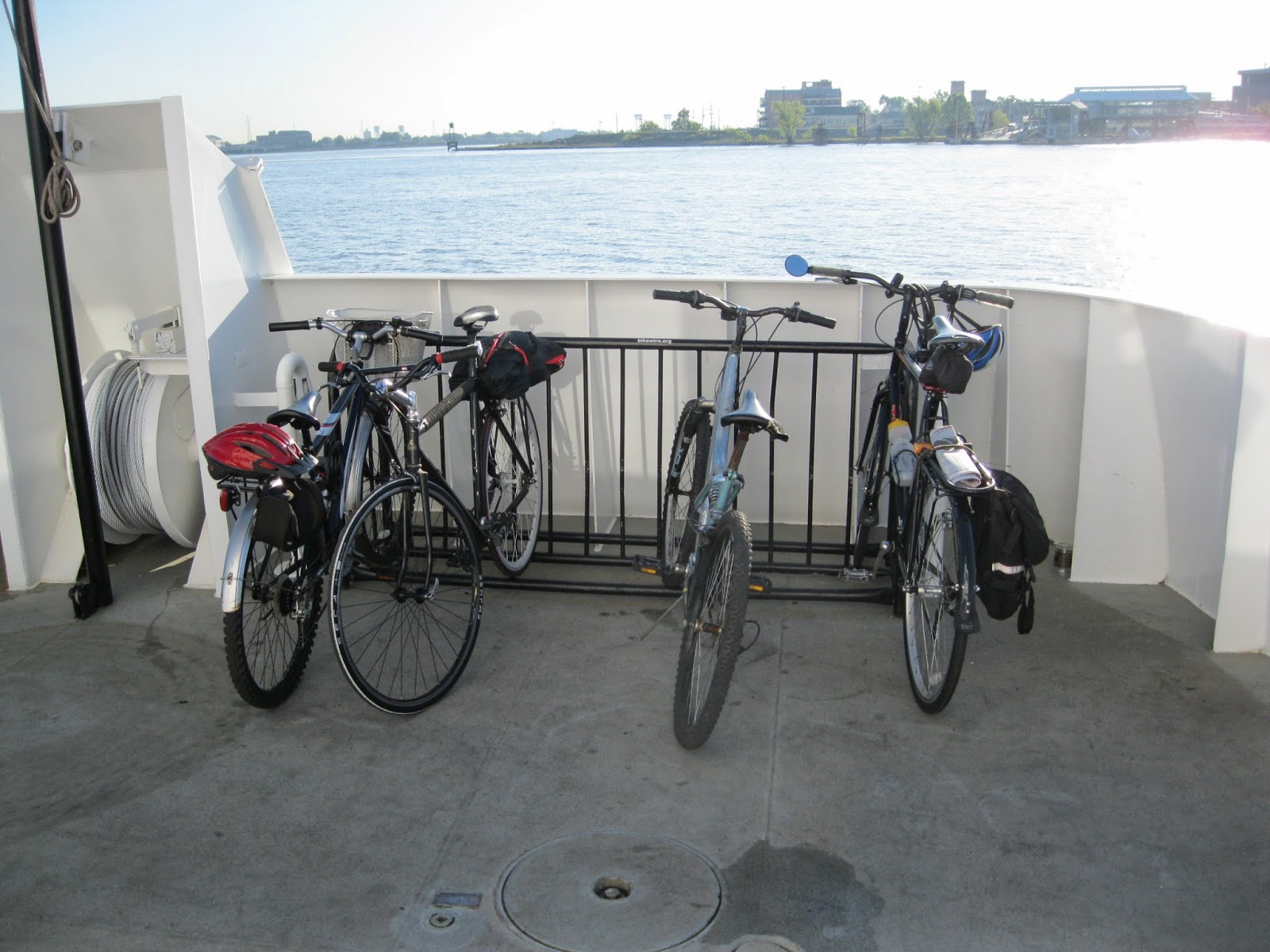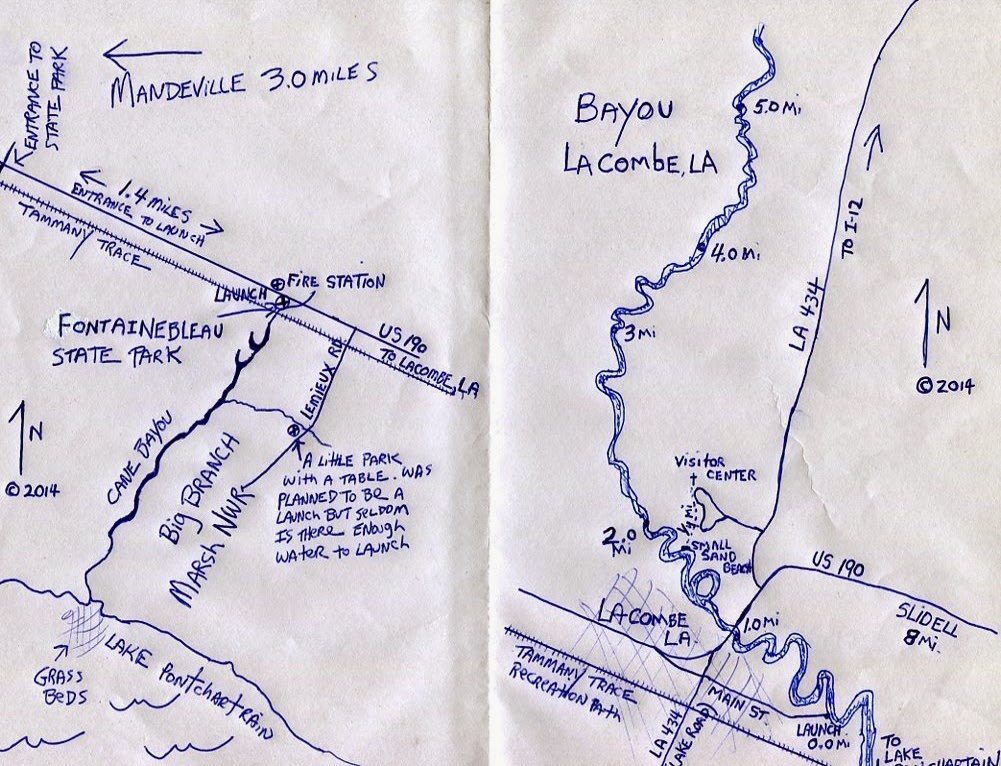 |
An early spring paddle on Bayou Lacombe, LA
|
Bayous Cane and Lacombe, slack and brown waterways draining the upland pine forests, swamps and vast marshes of Lake Pontchartrain's northshore, can provide paddlers with distinctly different paddling experiences despite flowing only a few miles apart.
To be sure, both bayous, about an hour's drive north of New Orleans, LA, have lots in common: nearly zero current allowing easy travel up and downstream, bald cypress trees draped with beards of Spanish moss, at least part of the way, muddy, spongy banks, beaucoup alligators and an astounding variety of shore birds and neotropical migrating birds, especially in spring.
But the bayous are different. Let us start with Bayou Cane, about four miles east of Mandeville, LA.
Bayou Cane
 |
| On Bayou Cane paddling to Lake Pontchartrain, winter 2013. |
Lunch into Bayou Cane, from the undeveloped boat launch off US.190. Hard-packed sand and shell, the bank, slightly smaller than a basketball court, gradually slopes to the water. From here it is a two-mile trip to Lake Pontchartrain, almost a straight shot. Bayou Cane is well known among locals and rare is the parking area empty of cars even on weekdays. There are no facilities of any sort.
The wetlands flanking the bayou are considered to be the last undeveloped large natural area on the north shore of Lake Pontchartrain. But the paddle starts with a short stretch through forested, piney uplands. A wooden RR trestle built for train traffic over a century ago, now is used by non-motorized recreational traffic on the Tammany Trace, a paved recreation path stretching 28 miles across St. Tammany Parish.
Paddling toward the lake on the right bank is Fountainebleau State Park, on the left bank the 19,000 acre Big Branch Marsh National Wildlife Refuge. On high ground to the left just past the RR bridge is a large brick house said to have once been the television studios of Cajun humorist, Justin Wilson. Wilson, born in Tangipahoa Parish, was the star of a cooking show that appeared on public television for 30 years. He died in 2001.
Downstream from the bridge the bayou widens as paddlers leave the noise from busy US 190 astern. Stay to the left at what appears to be a fork in the bayou just down stream of the bridge. About a mile downstream the trees suddenly stop and the scenery changes to marsh. Thick stands of wire grass, and cane, some of it six to eight feet high grows from the silty black muck, crowding the banks. Small sloughs and waterways cut paths through this tan and green curtain leading away from the bayou's distinct channel. This is alligator habitat and the chances of seeing one or more of the fearsome reptile are very good, especially if the weather is warm.
A diversity of habitats based on elevations that vary by just inches, populate the marsh. In the spring and fall wild flowers bloom. Fur bearers such as mink, otter, raccoon, muskrat, nutria rat and many other non-game species may be seen.
In a tall solitary dead tree in a open area halfway between the lake and the launch, a large osprey nest rests. Brown pelicans, the state bird, can be seen in winter. The ridges and swamps on the north shore of Lake Pontchartrain offer one of the first significant landfall habitats for neotropical migratory birds after their trans-Gulf of Mexico migrations.
Reaching the lake, if the wind in light or blowing off shore paddlers in canoes can venture into the open water and explore east and west along the lake's shore where a seemingly endless marsh grows right to the water's edge. Go far enough in either direction and you might find a sliver of sandy beach on which to have a picnic lunch. If the wind is from the south and creating a chop it is best to stay within the banks of Bayou Cane.
Tahe shallow lake bottom t the entrance to Bayou Cane is covered by a large grass bed of eelgrass, wigeon grass and spike rush. These fragile underwater grass beds provide a home for animal life while helping to purify the lake's waters. The lake's shallow bottom tapers very, very gently away from the grassy north shore, the water in the lake only hip deep 50 yards from shore.
(Pollution in the lake is much less of an issue than it was 20 years ago when shell dredging in the lake kept the shallow waters constantly murky, smothering benthic flora and fauna. Now, bacterial pollution from communities draining into the lake is the biggest risk to recreational users of the lake.)
Finding the boat launch
The launch is adjacent to the south side of highway US 190 east of Mandeville. There is no sign on the highway. The speed limit on this stretch is 55 mph and you must slow considerably to make the right turn off the highway onto the sand, dirt and shell launch area. The turn is about four-tenths of a mile east of the blinking yellow light at the main entrance to Fountainebleau S.P. Your landmark is a fire station almost across the highway on the left (when driving east) from the right turn into the launch parking lot. If you cross the bridge you have driver too far.
What about paddling upstream of the launch going under the US190 bridge? Well, shortly after loosing sight of the launch, a series of downed trees block progress up stream.
Bayou Lacombe
Main St. in Lacombe deadends at the bayou Lacombe. Here is a public boat launch used by paddlers. There is a small area at the water with a grass and sand shore for launching canoes and kayaks.
The bayou is broad here, at least 50 yards to the far bank. Kayak fisherman often launch here and head downstream to Lake Pontchartrain or look for deep fishing holes between the lake and the launch. Redfish, speckled trout, largemouth bass, catfish and bream are among the fishes found in the bayou, USFWS brochures say.
Paddlers with a mind for nature study and contemplation are encouraged to head upstream. The first two miles affords views of large wooded waterfront lots on high ground with manicured backyards sloping down to wooden decks where big boats are docked. Shortly after passing under the US 190 highway bridge the bayou becomes the western border of the headquarters of the Southeast Louisiana National Wildlife Refuges Bayou Lacombe Center and Visitor Center and Gardens, aka the Bayou Lacombe Center and the scenery becomes a bit wilder.
Here the bayou winds and splits, flowing through a series oxbows and bottomland hardwood hummocks. You are out of sight of manmade structures for part of the journey, giving the small area the feeling of a remote wilderness despite being only yards away from suburban intrusions. Have no worries about becoming lost here: all the waterways are short and eventually reconnect with the main channel.
Less than a mile upriver of the US 190 bridge, look for the small sand beach (there is only one sand beach on the bayou) east off the bayou's main channel. Pull up on the sand and take the quarter mile walk up to the refuge visitor center. The USFWS bought the Holy Redeemer seminary campus a few years back, turning the former chapel into a visitor center featuring wildlife dioramas, interactive displays and exhibits exploring the wetland ecosystems and wildlife of the eight USFWS refuges administered from the Lacombe headquarters. The museum is run by volunteers and is open Thursday-Saturday, 9:00 am to 4:00 pm. There is a bookstore, gift shop and restrooms and a drink machine. Admission is free.
There are several self-guided hikes up to two miles on the walkways and trails of the USFWS campus. Some pass through formal camellia gardens, native forests and wetland areas. Bug repellent is recommended year around. The trails are open Monday-Saturday, 7:00 am-4:00 pm.
Once back in the boat, how far you paddle upstream from here depends a lot on your stamina. The current is almost nil from the launch to the USFWS headquarters (unless it has rained heavily recently). But as the banks change from swampy muck to piney upland terra firma, the bayou becomes less bayou-like and more creek-like. The downstream current gradually gains momentum. About four miles upstream of the launch the current is not rippin' but even kayak paddlers will have to work their stroke to keep their forward speed up against the opposing flow.
Refuge property does not extend much up stream from the headquarters. Yet long stretches of the bayou remains in a semi-wild state. Homes and camps are built back from the bayou edge. Intrusive housing stock is rare and most of the shore is a mix of pine uplands and bottomland hardwood hummocks reflecting into the mirror-still dark brown bayou. Outside the USFWS holdings, and a couple of state and federal facilities barring public access, all the land is privately owned leaving no place to step out of a canoe or kayak. Even so dense vegetation on the bank makes getting out of a kayak or canoe unscathed difficult.
Paddlers will find plenty of water in the channel all the way to the I-12 highway bridge but the way might be blocked by fallen trees.
Quite paddlers have a chance of seeing lots of bird life. There are, of course alligators and lots of them if the weather is warm. In summer banana spiders with bodies as big as ball point pens spin their webs across the waterway high above paddlers on the dark water's surface. Summer also brings increased motorized boat traffic to the bayou but much of it is in a No Wake zone. Locals claim the signs are enough to keep things civil.
For more information:
Southeast Louisiana National Wildlife Refuges Bayou Lacombe Center Visitor Center and Gardens, 61389 Highway 434, Lacombe, LA 70445. Telephone 985/882-0093 or 985/882-2000. On the web find them at www.fws.gov/bigbranchmarsh/
Paddling Through Time: How humans have interacted with and changed the land over time along Cane Bayou. A canoe excursion on Bayou Cane led by the Friends of the Southeast Louisiana Refuges and held to raise money to buy more canoes and hire interpretative staff. Registration is only by mail or in person when the visitor center is open. You HAVE to preregister for each trip. See calendar of events at the Big Branch Marsh web site for important details. Each paddler pays $10 and that includes the canoe, paddles and PFD. You bring your own water, snacks, rain gear and bug repellent. Trips begin at 9:00 am and last for two or three hours. The trips are geared for adults but if you want to bring a kid, contact the Friends. Don't just show up with a child.
For kayak rentals:
Bayou Adventure, 27725 Main St., Lacombe, LA. 70445, at Lake Rd. (LA 434) Phone 985-882-9208. Kayaks rent for $35. Free delivery to Main St. boat launch in Lacombe. Delivery charge to Cane Bayou is $10. www.bayouadventures.com.
-30-







